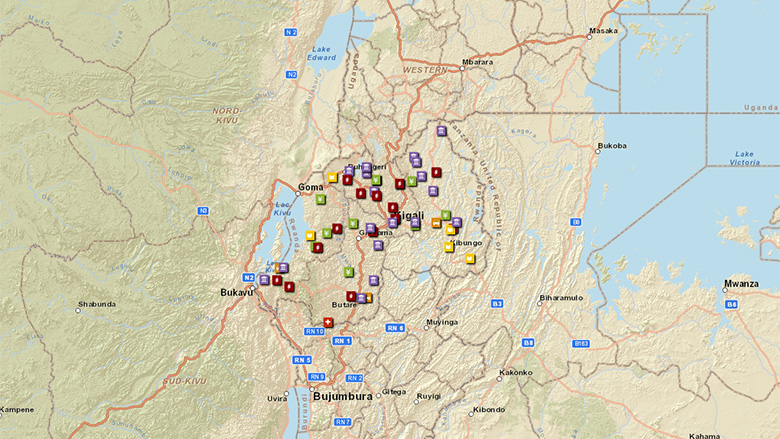Challenge
Agriculture is crucial for Rwanda’s growth and reduction of poverty, as the backbone of the economy, it accounts for 39 percent of gross domestic product (GDP), 80 percent of employment, 63 percent of foreign exchange earnings, and 90 percent of the country’s food needs. The sector is challenged by land constraints due to population pressure, poor water management, small average land holdings, lack of public and private capacity, and limited commercialization constrained by poor access to output and financial markets. The country’s average annual income of $550 per capita reflects a rural poverty rate of 49 percent, a figure that soars to 76 percent for families whose main source of income is agriculture.
Solution
The World Bank has expertise in agricultural intensification in the region, as well as with watershed management in hillside rehabilitation. Agricultural intensification must be executed in potentially fertile hillside land, where most of the arable land is located. The Rwandan authorities have a strong commitment to this project, and the government requested IDA support.
The project set out to increase the commercialization and productivity of hillside agriculture targeted for development through increased agricultural productivity of selected crops in targeted areas, increased productivity of targeted areas, and increased share in commercialized products from the targeted areas. The program aimed to improve land husbandry and productivity in seven pilot watersheds covering 10,250 ha of land, of which 1,868 ha would be irrigated. The watershed approach employed by the project involves infrastructural development and farmer education on intensification and land husbandry technology best practices.
Results
The Land Husbandry, Water Harvesting and Hillside Irrigation Project (LWH) was able to mobilize beneficiaries quickly for sensitization, implement a labor-intensive approach to land works, and complete a set of land husbandry works on one site while preparing another three sites. In addition to the successes highlighted below, the project has become a very important source of employment in the country. Some of the workers come from neighboring villages and walk more than four hours to reach the sites.
- More than 7,000 people have been employed by the project in land husbandry works.
- Approximately 19,828 Rwandans have benefited from the project directly, 9,587 of whom are women.
- Seventy percent of the target proportion of farmers in project-affected areas is using improved farm methods in year 2, 52 percent of whom are women.
- Forty-one percent of the land on the first four sites has been protected against soil erosion, representing 23 percent of the total project area.
- Rainfed productivity has reached $2,240 per non-irrigated hectare in just one season, surpassing the year 2 target of $1,000 per hectare.
- The share of commercialized products from target areas is 69 percent, surpassing even the project-end target of 60 percent.
- Two-thirds of farmers in project areas have adopted improved farm methods.
- Around 83 percent of women and 92 percent of men are using formal financial institutions.
- Around 2,346 hectares of land has been protected against erosion in project areas.
- Cooperatives in project areas had earned $5,129 by December 2012.
Bank Group Contribution
As of June 2012, IDA had contributed $9,901,461 to the project, with an additional $24,098,539 left to spend.
Partners
The Global Agriculture and Food Security Program (GAFSP), the U.S. Agency for International Development (USAID) and the Canadian International Development Agency (CIDA) served as partners in this project.
Moving Forward
The project is now seeking to hire dedicated staff for community development and procure support organizations to focus on community mobilization, group development, gender integration, and link with savings mobilization and credit. The project is also arranging South-to-South technical assistance to train staff and undertake training of trainers. The project will mobilize lending funds through the Africa Region Vice Presidency the Business Development Fund, the Association of Microfinance Institutions, and the banks.
Beneficiaries
Jean Baptiste Nizeyimana dug holes in gardens for $1.58 per day, often unable to meet his family’s needs, and sometimes going without food. Thanks to a Ministry of Agriculture Project supported by LWH, Nizeyimana was offered free training in making manure, which he sells to farmers in his area, growing his income to almost $1,000 per month. “I only wish that the Ministry of Agriculture can sensitize more people and scale up such programs and projects to the whole country. This would help Rwandans overcome poverty and poor standards of living. I am a living testimony and would love to see many people’s lives transformed just like mine has,” Nizeyimana said.

